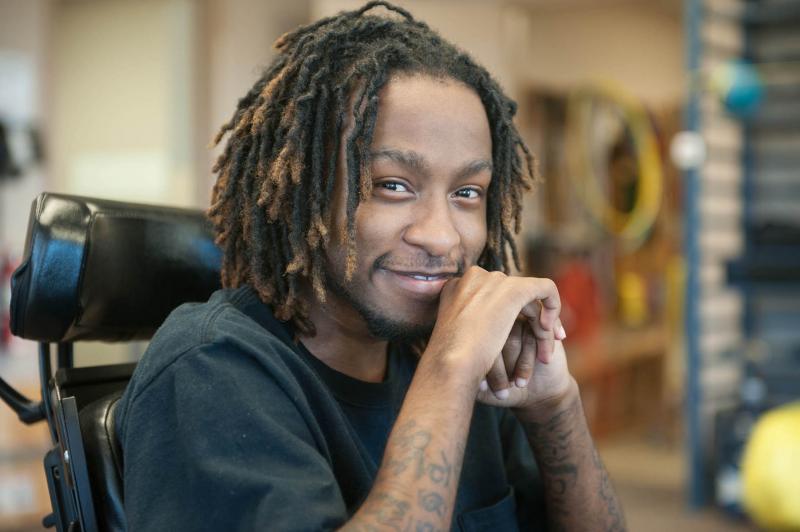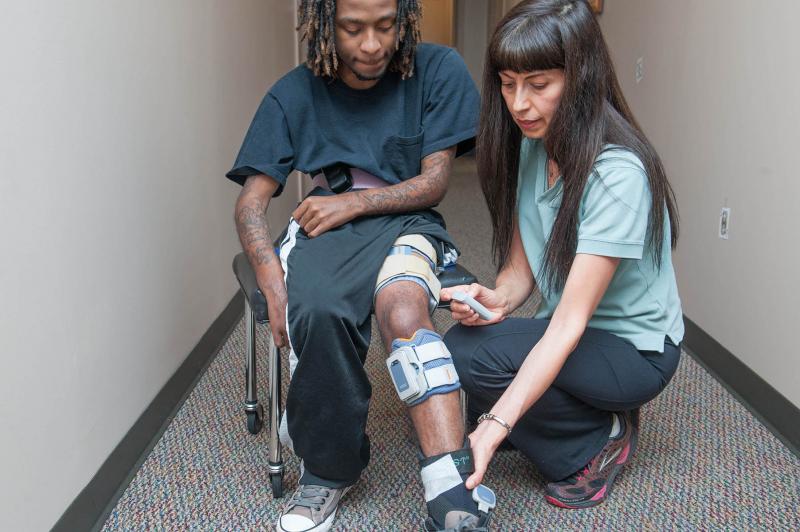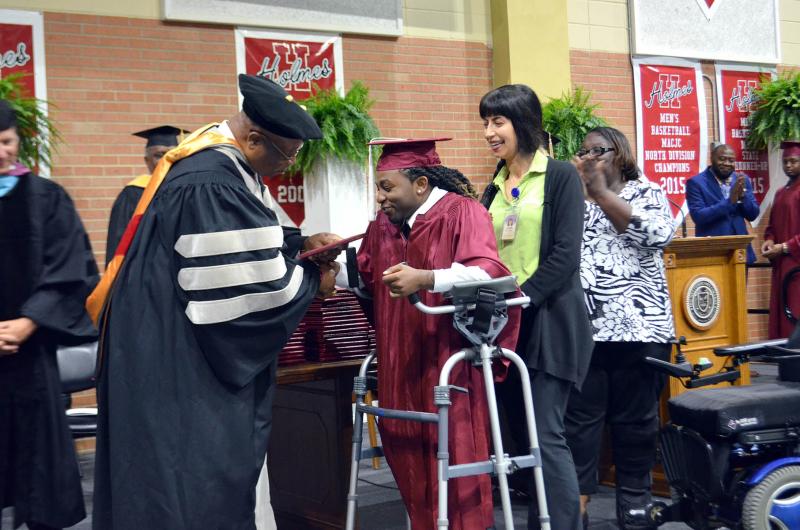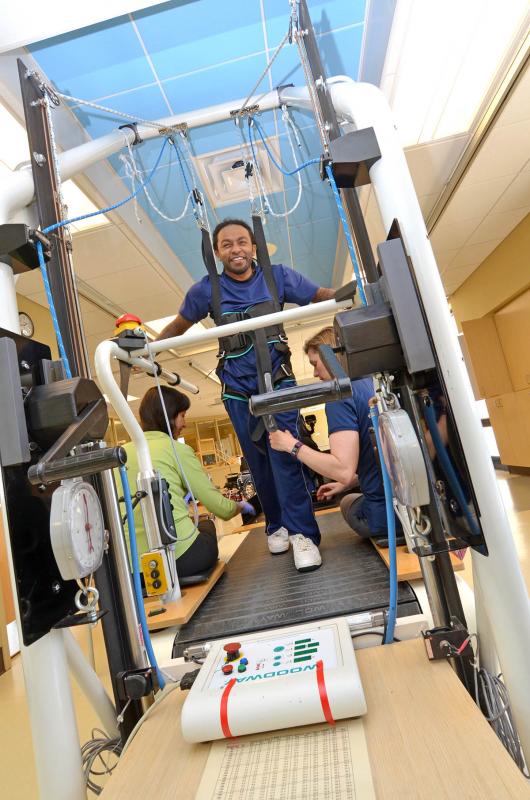When he ran high school track, 5-foot-tall Stevelyn Robinson used to fly over chest-high hurdles.
But that was nothing compared to his athletic performance at Holmes Community College’s commencement ceremony.
Supported by a rolling walker and the cheers of the crowd, the 23-year-old Winona resident rose from his wheelchair and slowly crossed the stage to receive his associate’s degree.
“You can do it,” someone shouted. And Patricia Oyarce never doubted that he would.
The Methodist Rehabilitation Center physical therapist has been by Robinson’s side during most of his more than five-year battle to overcome a paralyzing spinal cord injury. So she was among his many happy supporters on the big day.
“Stevelyn and I have been working together for four years, and I don’t ever remember him not being willing to do something,” Oyarce said. “It has been an honor for me to be part of his journey.”
The accident that put Robinson in a wheelchair happened the morning of Dec. 2, 2011. The senior was on his way to Montgomery County High School in Kilmichael when he saw a log truck bearing down on his bus.
Robinson leapt up to shield his then 12–year-old sister Jazalyn. And it would be the last moment he moved with the grace of a three-sport athlete. After the crash, doctors found four broken vertebrae in Robinson’s neck.
“They told me I was paralyzed from the neck down,” he said. “But something told me not to give up.”
Robinson’s arms and legs lay useless by his side when he first arrived at Methodist Rehab, a Jackson hospital that specializes in treating disabling injuries and illness.
But a few weeks later, he did something that set a fire under the hospital’s spinal cord injury team.
“I came in one Monday and Stevelyn said: ‘Look what I can do,’” remembers Methodist Rehab physical therapist Ann Howard. “He lifted one leg and our therapy changed.”
The movement meant Robinson might recover muscle function below his injury site. So staff began brainstorming ways to build on his returning abilities.
Over the course of his therapy, he “pedaled” on an FES (Functional Electric Stimulation) Cycle that stimulated his nerves and evoked leg muscle contractions. And he eventually graduated to a Bioness L300 Plus, a wearable device that uses low level electrical stimulation to achieve a similar effect.
He was also custom-fit with a stabilizing leg brace, a helpful hand splint and treated with Botox injections to ease severe muscle contractions. And he benefitted from the center’s adaptive computing lab, wheelchair seating clinic and driver rehabilitation program.
“He’s a good example of our continuity of care, teamwork and collaboration,” Oyarce said.
For the past year, Robinson has worked with Oyarce and physical therapist Kathleen Dobbs on Methodist Rehab’s weight supported treadmill system. They used the system to off-load a precise portion of Robinson’s body weight, allowing him to practice stepping motions while strapped into a parachute-style harness.
“It gives him a chance to practice repetition,” Dobbs explained. The exercise produces important sensory input that encourages new neural pathways in the spinal cord.
In addition to the treadmill training, Robinson has also been immersed in Quest. The Methodist Rehab outpatient program helps brain and spinal cord injury patients return to work, school or community life. And staff there focused on helping Robinson enter college.
The late Julie Walker, Quest’s former therapy manager, was particularly persistent. And Robinson gives her credit for much of his academic success.
“If she hadn’t been on me, I probably wouldn’t have graduated,” he said.
Oyarce and former Quest psychologist Danny Burgess also were motivating forces, particularly when it came time to switch from online courses to on-campus classes at Holmes’ Grenada site.
“I was discouraged by the fact I was in a wheelchair, and I didn’t think I’d make any friends,” Robinson said. “But Patricia told me I would not know until I tried. And Danny told me I was not getting any younger.”
To ease Robinson’s move onto campus, Quest staff met with Holmes personnel to map out an accessibility plan.
“Our teachers are really good about getting to know students and making necessary accommodations,” said Laura Bigbee, student services and disabilities coordinator at Holmes.
“Our goal is to level the playing field, regardless of whether a student is in a wheelchair or hearing or vision impaired. They have the same opportunities as anyone on campus does. Regardless of the situation, you want them to be able to fit in.”
To ready for Robinson’s arrival, the school extended a sidewalk to provide better wheelchair access to the library. And they also made accommodations for his mother, Sheila, to be his classroom aide.
As time neared for Robinson’s graduation, Oyarce, Sheila and the college staff began putting together a plan for the ceremony.
Robinson was to move across the stage bolstered by a rolling walker, while Oyarce and his mom followed to offer support. They even practiced for the moment with Robinson in his cap and gown.
On graduation day, Robinson decided to forgo his leg brace in order to wear fancy dress shoes. So his march proved more belabored than usual.
But judging by the audience reactions, it was still a feat to behold.
“Oh my gosh, I was in tears,” Bigbee said. “I have a disabled child myself, and to see that was a lot of motivation. It really touched me.”
It also made Sheila and Oyarce misty-eyed, but Robinson was all smiles. More than anyone, he realizes how far he’s come.
“It’s unbelievable,” he says. “I was in the ICU thinking I wouldn’t be able to move at all, and now I can walk with assistance.”
Robinson plans to attend the University of Mississippi in Oxford in the fall to pursue a degree in computer engineering. “My long-term goal is have my own business,” he said.
And his therapists don’t doubt he’ll overcome any hurdles in his path.
“Even on bad days, when he didn’t feel well and his body didn’t do what he wanted it to do, he would work so hard,” said Methodist Rehab occupational therapist Suzanne Colbert. ‘He’s always willing to find a way to get something done.”




